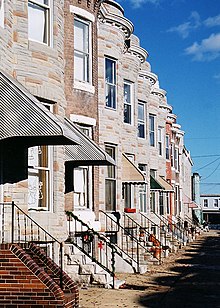Formstone

Stone form ( dt. Approximately shaped block , but not to be confused with shaped block ) was a method for cladding by means of artificial stone , which in the United States was popular in the 1940s and 1950s.
Invention and use
The Formstone process was developed and patented in 1937 by the Baltimore entrepreneur Albert Knight . The concept consisted of applying galvanized wire mesh to the existing facade and fastening it with nails; the fine-meshed wire mesh should hold the actual artificial stone. A 1.3 to 1.9 centimeter thick first coarse layer of the cement-like artificial stone mass was then applied to the facade surfaces covered with wire mesh. Once this was dry, it served as a substrate for the second, equally thick layer, which was applied and modeled while it was still damp to resemble natural stone masonry.
Knight believed his cast stone cladding would be of interest primarily to owners of detached single - family homes in Baltimore. Contrary to his assessment, townhouse owners quickly became his main customers. The main reason for this was that the terraced houses typical of Baltimore were mostly built from poor quality, very porous bricks . They had to be painted regularly with thick layers of facade paint, otherwise the bricks would crumble due to the weather. The homeowners expected the Formstone cladding, which was advertised as maintenance-free and the cost of which was approximately the equivalent of three coats of paint, a considerable saving in money and future effort. Another reason for the popularity of artificial stone facades was the widespread desire to increase one's own reputation with a house apparently made of natural stone and therefore of higher quality.
Spread and decline
Knight was able to market its process quite successfully as a franchise with a total of 25 concessionaires throughout the United States with the exception of the Northeast, but in Baltimore and the surrounding area Formstone achieved a particularly wide distribution. At the beginning of the 1950s, large parts of the city hardly had a facade that was not clad with artificial stone in this way. Formstone shaped the cityscape in such a striking and ubiquitous way that Baltimore has also been called the Formstone capital of the United States . At this time, Formstone also passed its zenith: It turned out that the artificial stone was sometimes less durable than the advertising claimed and tended to crumble off the facades. In addition, new types of facade cladding made of aluminum and vinyl plastics became more popular and displaced formstone.
Baltimore is still largely characterized by the Formstone facades of the 1940s and 1950s, but they are increasingly disappearing from the cityscape. Since they are now perceived as ugly, tasteless and uncultivated , homeowners often have the artificial stone cladding removed and the original brick facades exposed and repaired.
documentary
In 1998, the American director Skizz Cyzyk shot the documentary Little Castles: A Formstone Phenomenon (German title: The slightly different house facade ), in which he portrayed the history of the Formstone facades and their extraordinary popularity in Baltimore. In addition to contemporary witnesses and experts, the Baltimore-born director John Waters has his say and sums up the character of the artificial stone cladding with the words Formstone is the polyester of brick .
